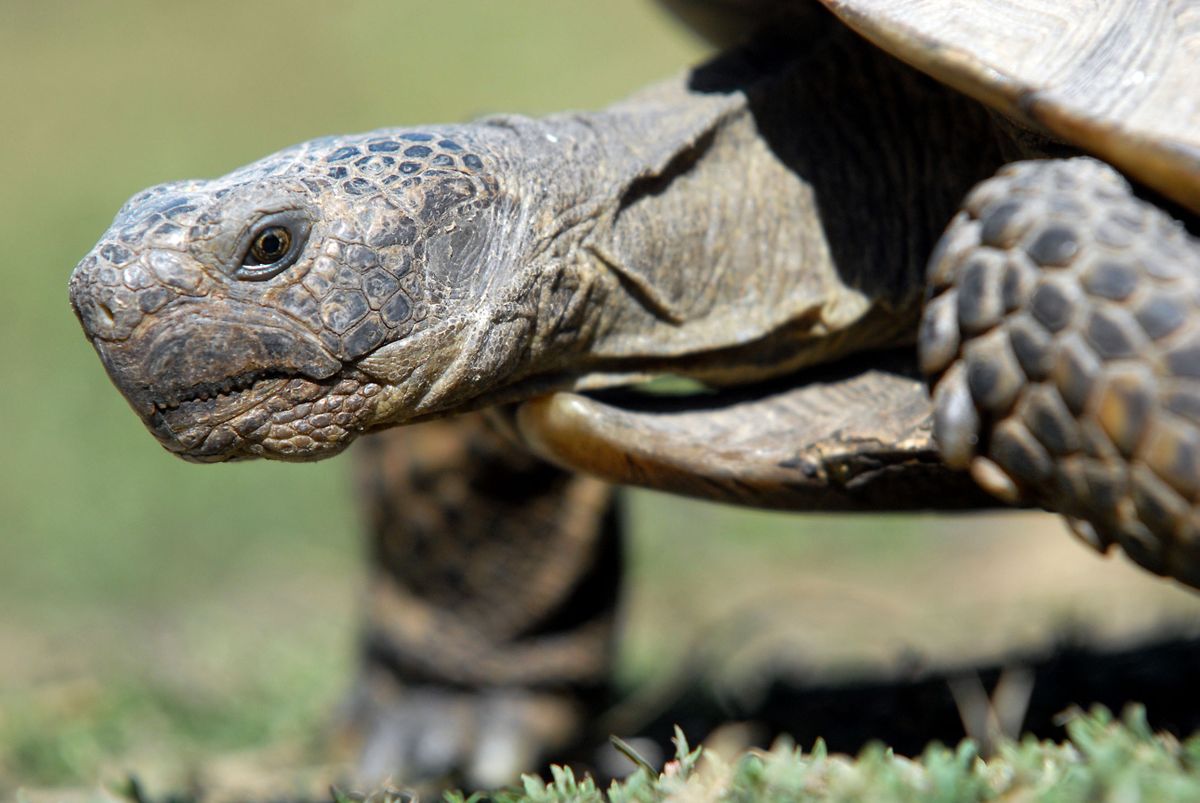Tortoise needs lift to warmer climes
Desert reptile found at U.S. 95 rest stop

Sadie was abandoned at a U.S. Highway 95 rest stop, southeast of Spokane and far from her Mojave Desert home.
It’s unclear how the desert tortoise got to the rest stop. Maybe someone found out their Southwestern souvenir was a threatened species protected by law. Maybe she was a longtime family pet accidentally left behind. Maybe, like so many other animals along highways, someone just couldn’t care for her anymore.
The 10-inch tortoise was rescued and given refuge in July at Dotty Cooper’s wildlife rehabilitation center in Cusick, Wash. While the Kiwani Wambli center has been a good home, the terrain here is strange for a desert tortoise. The food is strange. The Inland Northwest is not like the Southwest, especially as winter nears. This culture-shocked tortoise needs to go home.
Not that she’s been an ungrateful guest.
“She’s the mostly friendly reptile I’ve ever seen,” Cooper said.
Sadie even turned out to be a helper for the orphaned fawn that shared her pen. It’s often hard to teach fawns how to eat, Cooper said, because humans can’t show them how to forage and eat greenery from the ground very well. But with Sadie around to demonstrate, this fawn caught on with little trouble. The duo also became partners in crime after Sadie dug a hole beneath the plastic fence.
“When I got home, she and the deer were marching down the road,” Cooper said.
But the fawn is gone, released back into the wild, and the nights are getting colder. The dandelions Sadie likes to eat are getting scarce. Cold-blooded desert tortoises aren’t made for temperatures below 40, let alone the kind of northern winters that brought enough snow last year to collapse part of Cooper’s barn. Sadie could only survive by staying huddled indoors for months.
So Cooper started a quest to get Sadie home. The tortoise can’t just be released into the desert, because she could have acquired foreign germs that might wipe out her relatives.
“Once they’ve been touched by humans they’re now a domesticated pet. They’re no longer classified as a wild animal,” said Ginger Wilfong, who runs the Bay Area Turtle and Tortoise Rescue near San Francisco with her husband, Gary.
Cooper got in touch with the Wilfongs, who are certified to care for tortoises and find them adoptive homes. They own 115 tortoises, but can have anywhere from five to 500 brought in each week looking for new homes.
“I haven’t mowed the lawn in years,” Wilfong said.
They make great pets, she said, and each has its own personality. Much like humans, desert tortoises mature between 14 and 20 years of age with typical life spans of 60 to 100 years. The U.S. Fish and Wildlife Service designated the species as threatened in 1990, and several states have additional laws to protect them.
“Finding her a place where she can go in the sunshine and live as normal as possible has been a challenge,” Cooper said.
Meanwhile in Blythe, Calif., Wayne Cusick received a copy of the Newport Miner’s article about Sadie from a friend. Cusick and his wife, Lee Ann, visit friends at Diamond Lake every summer and have stopped in Cusick to ask about the town’s familiar name. Back in Blythe, adopted tortoises are common in backyards.
It seemed like fate, and Cusick called Cooper right away.
“I explained our situation and how maybe it was destiny for this tortoise to wind up with the Cusicks in Blythe, California, here in the midst of the Mojave Desert,” Cusick said.
Sadie will even get a playmate: young Speedy, who’s about half her size.
The happy ending is hopeful, but Sadie’s travel itinerary from Cooper to the Cusicks is unclear. Because of her protected status, UPS won’t touch her. Cusick said he could drive the four hours to meet a chauffeur in Los Angeles, but not the whole trip up to Washington and back.
Since the article was published in Newport three weeks ago, offers for rides have been trickling in from people like Donna Nelson and her husband, Clare, who offered to give Sadie a ride when they head south in their RV later this month.
“We’re kind of animal lovers and wanted to see the poor little turtle get back where she belongs,” Nelson said.
But the Nelsons are swinging through Montana to see their son, making it a longer road trip than allowed by the permit to transport a threatened animal. A few offered to drive, but can’t take on the gas costs. Others aren’t leaving until October.
Cooper and Cusick are hoping some big-hearted snowbirds or other southbound travelers will be able to give Sadie a direct ride – and soon. This week frost crept onto the pumpkins at the Kiwani Wambli center. Winter won’t wait.
“It’s just way too cold,” Cooper said. “She needs to get there, the sooner the better.”
Cusick said they’ve even thought about trying to coordinate a sort of border-to-border hitchhiking tortoise relay.
“I somehow don’t think that’s going to happen,” he said, “but I’m hoping that between word-of-mouth and some notoriety, we’ll be able to find someone.”